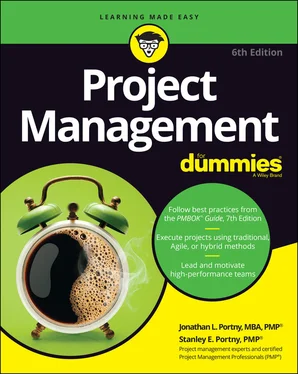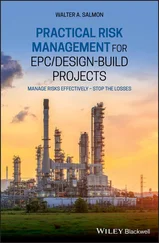1 ...8 9 10 12 13 14 ...26 10 Are you comfortable dealing with people at all organizational levels?
1 Although maintaining good working relations is important, the project manager often must make decisions that some people don’t agree with for the good of the project.
2 Most project managers achieve their positions because of their strong performance on technical tasks. However, after you become a project manager, your job is to encourage other people to produce high-quality technical work rather than to do it all yourself.
3 Believing in yourself is important. However, the project manager’s task is to help other people develop to the point where they can perform tasks with the highest quality.
4 The project manager tries to minimize unexpected problems and situations through responsive planning and timely control. However, projects are not always predictable and when problems do occur, the project manager must deal with them promptly to minimize their impact on the project.
5 Though coming up with ideas can help your project, the project manager’s main responsibility is to ensure that every team member correctly understands all ideas that are developed.
6 The project manager’s job is to provide a cool head to size up the situation, choose the best action, and encourage all members to do their parts in implementing the solution.
7 Self-reliance and self-motivation are important characteristics for a project manager. However, the key to any project manager’s success is to facilitate interaction among a diverse group of specialists.
8 Although you may feel (and we agree) that honoring one’s commitments is a fundamental element of professional behavior, the project manager needs both to ensure that people maintain their focus and to model how to work cooperatively with others.
9 People should be self-motivated, but the project manager has to encourage them to remain motivated by their job assignments and related opportunities.
10 The project manager routinely deals with people at all levels — from executive leadership to support staff — who perform project-related activities.
 Check out the table of contents to find out where we discuss these different aspects of the project manager’s job in more depth.
Check out the table of contents to find out where we discuss these different aspects of the project manager’s job in more depth.
Relating This Chapter to the PMP Exam and PMBOK 7
Pay special attention to Table 1-1, which notes topics in this chapter that may be addressed on the Project Management Professional (PMP) certification exam and that are included in A Guide to the Project Management Body of Knowledge, 7th Edition (PMBOK 7).
TABLE 1-1 Chapter 1 Topics in Relation to the PMP Exam and PMBOK 7
| Topic |
Location in This Chapter |
Location in PMBOK 7 |
Comments |
| Definition of a project |
“ Determining What Makes a Project a Project” |
Appendix X4. Product |
The best definition of a project in PMBOK 7 is in Table X4-2, Unique Characteristics of Projects, Programs, and Products, of Appendix X4. The definition in this book is the same. |
| The phases in a project’s life cycle |
“ Describing the four phases of a project life cycle” |
2.3.5. Life Cycle and Phase Definitions |
PMBOK 7 has shifted away from the traditionally-prescribed four phases of a project, in favor of tailoring one’s approach to define the optimal life cycle for each project. This book still discusses the four traditional life cycle phases, as that is still the most common project structure. |
| Stewardship and Leadership principles |
“ Starting with stewardship and leadership” |
3.1. Be a Diligent, Respectful, and Caring Steward 3.6. Demonstrate Leadership Behaviors |
The definitions of these project management principles are the same in PMBOK 7 and in this book. |
| Team and Stakeholders principles |
“ Continuing with team and stakeholders” |
3.2. Create a Collaborative Project Team Environment 3.3. Effectively Engage with Stakeholders |
The definitions of these project management principles are the same in PMBOK 7 and in this book. |
| Value and Quality principles |
“ Delivering value and quality” |
3.4. Focus on Value 3.8. Build Quality into Processes and Deliverables |
The definitions of these project management principles are the same in PMBOK 7 and in this book. |
| Complexity and Risk principles |
“ Handling complexity, opportunities, and threats” |
3.9. Navigate Complexity 3.10. Optimize Risk Responses |
The definitions of these project management principles are the same in PMBOK 7 and in this book. |
| Tailoring and Adaptability & Resiliency principles |
“ Exhibiting adaptability and resilience” |
3.7. Tailor Based on Context 3.11. Embrace Adaptability and Resiliency |
The definitions of these project management principles are the same in PMBOK 7 and in this book. |
| Systems Thinking and Change principles |
“ Thinking holistically and enabling change” |
3.5. Recognize, Evaluate, and Respond to System Interactions 3.12. Enable Change to Achieve the Envisioned Future State |
The definitions of these project management principles are the same in PMBOK 7 and in this book. |
Chapter 2
I’m a Project Manager! Now What?
IN THIS CHAPTER
 Identifying the project manager’s role
Identifying the project manager’s role
 Understanding common pitfalls of being a project manager
Understanding common pitfalls of being a project manager
 Defining the four values of the project manager’s code of ethics
Defining the four values of the project manager’s code of ethics
We’re willing to bet that, because you’re reading this book, you’ve either been asked to manage a project or you’ve decided for yourself that you would like to get into project management. So, hang on tight — you’re going to need a new set of skills and techniques to make sure you’re successful in this role. But not to worry! This chapter gets you off to a smooth start by showing you what project management really entails and by helping to get you into the project management mindset.
Knowing the Project Manager’s Role
The project manager’s job is challenging. For instance, project managers often coordinate technically specialized professionals — who may have limited experience working together — to achieve a common goal. Although the project manager’s own work experience is often technical in nature, their success requires a keen ability to identify and resolve sensitive organizational, interpersonal, and project-related issues. In this section, we describe the main tasks that a project manager handles and note potential challenges they may encounter.
Looking at the project manager’s tasks
Historically, the performance rules in traditional organizations were simple: Your boss made assignments; you carried them out. Questioning your assignments was a sign of insubordination or incompetence.
But these rules have changed. Today your manager (and/or others) may generate ideas, but you assess how to implement them. You confirm that a project meets your leadership’s real need and then determine the work, schedules, and resources you require to implement it.
Читать дальше

 Check out the table of contents to find out where we discuss these different aspects of the project manager’s job in more depth.
Check out the table of contents to find out where we discuss these different aspects of the project manager’s job in more depth. Identifying the project manager’s role
Identifying the project manager’s role










